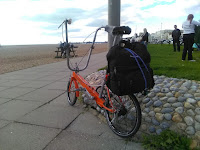Changed; 31-10-2024, 16-11-2024


Frame number; A3249 made in about 1976, is the date on the variable speed hub.
3-speed AW gear hub dated August 1976. I have greased the water-repelling labyrinths. Put the hub bearing nuts back with the slack corrected, which fixed the grinding when I got the bike and have over-oiled the hub which washed out a little rust.
These bikes could be purchased in 1977 in USA from UK for; $360 plus postage. About £200. I don't know what the price was in the UK?
 |
The handlebars fold down to form the bike's stand. But a side stand can be fitted. |
- Gear 2.1 m/stroke is only a little lower than 2nd on my Universal adult bike.
- Gear 2.8 m/stroke, is a little lower than 3rd gear on my Universal adult bike.
- Gear 3.7 m/stroke, is higher than my Lenton but lower than my Peugeot sports bikes highest speeds.
In conclusion the bike is not capable of very low speed unlike a modern stiff frame short wheelbase bikes. 3 to 8MPH, with 5mph is okay. But 2.5 to 12MPH are about the limits.
This original version Bickerton is made with off the shelf parts, aluminium tubes, rod, and beam, with minimal machining and cutting, bolted together. There is no aluminium welding, though that is a good method of joining parts because it does not fracture unlike steel welding that is brittle and does.
I purchased the bike in September 2024. It has been used for parts, so I scavenging parts for the bike. The bike is very maintainable and despite the manual warning to not take the gear hub apart, they both don't need much maintenance but for oiling they can be dissembled if you take lots of care, and read up on how to do that, the parts put back the right way and don't disassemble them more than you need too to clean or replace a pawl spring say. AW hubs if oiled regularly can be going fine at 1 million miles and 40 years on a postman's bike for example.
Engine oil is a good general-purpose oil for the transmission you can also use grease on the cable parts and the sliding tubes. Don't use 3-in-one oil inside the gear hub but it's okay on the chain as it leaves a hard protective coating.
The bike is allowed on most trains and buses folded and depending on guard, driver discretion and company policy full-size bikes are often allowed off-peak.
No bike side stand is fitted but you can unlock, move and lock the handlebars to use those as a stand, the manual suggests or have a side stand fitted as an extra.
 |
The removal of the rear wheel
requires loosening the seat post clamp and moving it a little. Once I
put the washer back on the hub and the one with the anti-rotation
washers on each hub side of the shaft with the locators facing out to
the frame, the pair of down tubes were extremely tight and scrapped
aluminium when I moved them. The flats on the shaft are now horizontal
but they were probably intended to be in line with the diagonal tubes to
the seat post, which is also difficult to do and seems less than ideal.
For newer Bickerton bikes the tube from the seat post is bolted to the horizontal tube rather than sharing the hub shaft.
All the tubes have been greased, fortunately, so they do slide as they should, leaving a silver of grease and aluminium on your hands though. The bike became much less wobbly to ride once I had greased the steering bearing, that can be the case with other bikes. Unsurprisingly, lubricating and correcting adjustments have made the bike lighter to ride.
A tool bag attached to the tube between the seat post lock and the crank would be useful.
The Bell chimes ding-dong on push then release.
Bikes do vary in how light comfortable, heavy, uncomfortable or stable they are, but there is no real rule about what frame design feature results in. This is the lightest adult bike I've experienced and heaviest to pedal but for its very low speed and low gearing. Postwar long-wheelbase bikes were the best of the best when Raleigh was at its height. This bike has shorter 60mm pedal arms compared to the normal 70mm that adult bikes have had for at least the past 80 years, but that is not enough to make the bike noticeably heavier to pedal.
The handlebar; one of the locking bolts was rusted and thread ruined, in any case, another did not lock the handlebars well. I replaced it with a bolt and a wing nut, but better still was a blind bolt with internal locking, foil wrapped around it a washer and a nut. Finally, I found a smaller-sized metric nut, that an old 1/2" ring spanner fitted tightly on. The ride is now much better, although the handlebars do slide, but less so.
- I
am advised that a modern seat post clamp would do a better job clamping the handlebars.
Having said that, what I have done is a good solution.
- In mitigation Bickerton says that the floppyness of the handlebars is intensional allowing the cyclist to lean back and pedal harder on hills. They also say it takes getting used but I worried about falling off backwards.
- The pin is a C-shaped roll of spring steel, tapered on both ends so it can be pressed back in from either end. I used a vice with the jaws open a little to press against and flat tool against the pin and a hammer.
- The bearings were clean but dry, which I greased with Castrol LM grease.
- The bearing nut was screwed tight, to ensure that the thread runs smoothly, then slacked to finger tight then held at 1/4 to 1/2 turn slack and the locking nut tightened onto it.
- The pin was then hammered back in using the tool again between the pin to hammer against.
- The pins function as stops. The steering now does not have any stiffness, consequently, the bike is now a little less wobbly to ride.
- Then a sawn-off nail tip to give a filed flat end nail to hammer the pin through the hole and out.

https://starostneradost.wordpress.com/tag/bickerton/
The sliding spanner on one pedal for unscrewing it to stow it out of the way;
 |
| Pushing in or pull the saddle out is difficult even after greasing the seat post but the seat slides down unless tightened very tight. |
It is like an anti-theft device, but I am sure the aluminium pedal arm's thread would not last under normal use and abuse if it had been used often? The hole between the seat post and the back wheel on the frame is to hold the pedal but it is missing a grommet or something. That is so it can go into its carry bag which I don't have.
The pedal drops into the storage hole but it is not locked in place. The pedal would squeeze between the mudguard and the seat post but as the bike is now is a loose fit.
 |
| I carry some tools and straps to fold and carry the bike. This IKEA bag is strong. |
A lovely, still, sunny day at the end of September, so I put the bike on the train and visited the seaside.
The cycle route along is flat between Hastings Old Town and West St Leonard's, seafront is okay until the hill to Ore and the hills behind to Bexhill-on-sea. The bike drew many friendly comments as well as that it is dangerous, which it is if I hit a pothole and the bike collapses under me. Lots of stops at lovely cafes like these and a bit of shopping, which is placed to not overhang the front of the rack.
This is just the sort of outing the little bike is well suited to, but my full size sports bikes cope with hills and potholes better when visiting Ore or Bexhill. They are light enough to put an off-peak train.
Android apps;
Google Maps is clearly readable but the bicycle and walking routes given are regular roads which can be bad, such as Southborough and High Brooms to Tonbridge the only route offered is via the A26. This app will give verbal instructions until you get near your destination when it stops. It tells you when to get off the train but tells you there are two stops to go when there is one stop.
Caynax rout plotter app. with graphical statistics - Movit gives good bicycle routes the A21 cycle path is offered instead of the A26 road. But the screen is cluttered. It Dings three times before a train stops you need to get off, the last being a double ding. This App. grow too large to remain installed on my Doro smartphone.
- Both apps. Can show the train stops that the train is not going to stop at and may not show the right connections?
- Both Apps will find a route and may adjust that route if you detour, but they must be started with an internet connection such as Wi-Fi.
- Any app. you might be able to select an alternative route with Google Maps use a bicycle route map (paper or one of the cycle route websites), select cycle or walk now, and place as many stop points on your route to steer it towards suggesting a fit with your rough plan. Other apps you can use their website to navigate and pull the route the way you want to go then use your creation on a smartphone.
- Caynax is a good tracker with a good automatic pause. ITO Pedometer, is simple, reliable and automatic for walking. Nix games Speedometer, is good. See this blog.
The Doro 8030 "smartphone" I use is not very smart, but the camera is okay. Android 5 does not support some of the good cycling apps Stava and Rides With GPS any more.
For more bicycles and maintenance please look at my other blog links on the right-hand margin of this blog such as; pandemic-and-cycling-going-forward






































